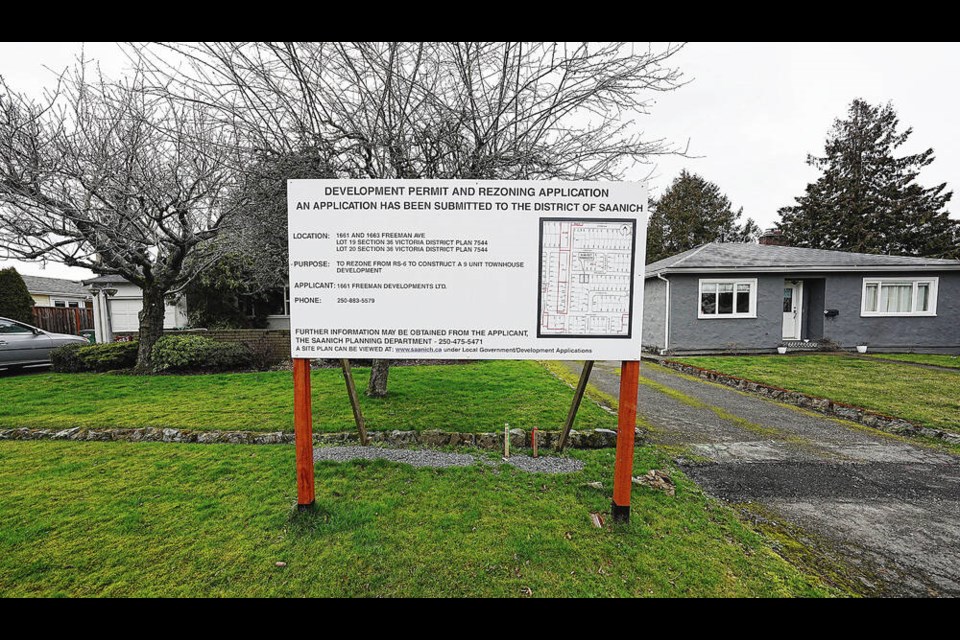Saanich says it’s trying to improve its processes for approving new housing amid criticism that it’s a bureaucratic quagmire for developers and homebuilders.
Mayor Dean Murdock admits Saanich has been called out for the time and effort it takes to approve development and building permits compared to other jurisdictions, but he said the district is working in it.
“There’s some modernization that has needed to happen and that is now beginning to pay off. It’s a process and it’s going to take some time for it to be completed,” he said. “But we’re responding to those concerns and we’re working to be facilitators of community development.”
Murdock said council candidates heard from Saanich residents during October’s municipal elections that the district needs to get to work to build housing of all kinds.
A 2020 housing-needs report prepared for the district by Urban Matters CCC showed Saanich could require 3,049 new homes by 2025 and the community could see 5,290 new households by that date.
The district has a housing strategy with a number of goals, such as finding new non-market housing opportunities, and developing a program to provide housing types other than single-family homes and condos, while supporting more purpose-built rental projects.
Murdock said to tackle those goals, Saanich staff are trying to make processes more efficient, which can be difficult within large organizations. They’re also trying to build a culture where they work with the developers as partners in community building, he said.
“But it’s a process. I think we’re starting to get somewhere with clearing the backlog and getting files in front of council much more quickly,” he said.
There was some evidence of that when recent staff reports on new developments that align with the official community plan went to council with the recommendation that they move ahead without public hearings.
Murdock said council had the option of skipping the public hearing but chose not to in one of those cases — a six-storey multi-family project on the Shelbourne corridor — due to public outcry.
“It’s very clear that we need to be able to move more quickly and have processes that are responsive to the need to make approvals happen more quickly,” he said, noting that Shelbourne development in particular drew a crowd to the council chambers to voice concerns.
“But I think we also need to be sensitive to the fact that we’re managing change in neighbourhoods, and in some cases, that’s coming quite quickly and people will be understandably frustrated or concerned.
“It’s important that we give them an opportunity to have input into that process. So, council has to strike a balance.”
Casey Edge, executive director of the Victoria Residential Builders Association, said so far, he hasn’t seen any efficiency improvements coming out of Saanich, noting a mid-sized townhouse project that was years in the making recently went through three public hearings before finally getting a green light from Saanich.
“And now there’s this other [Shelbourne] project that meets the OCP and Saanich staff recommended no public hearing, but they’re going to a public hearing anyway,” he said. “I don’t get it.”
Edge said the OCP process is open to the public and is created with public input, yet in the case of the Shelbourne condo project, the district decided to slow things down.
“Now we’ve got small groups of people who are flooding the council chambers and getting public hearings against the [district’s] professional staff recommendation,” he said.
“Saanich often comes up with these great strategic plans and has for the past few years about how they’re going to expedite housing, but on the ground, when you submit a project, you don’t see any of that. It’s just regulatory obstruction and cost.”
Kathy Whitcher, executive director of the Urban Development Institute, said some developers have found working with Saanich difficult, but she understands there are plans to change.
“They’ve hired some more staff and they do recognize that they have an issue and so they’re working on it, which is great,” she said.
As for some projects being able to skip the public-hearing process, Whitcher said that’s always been an option.
“It’s actually been around for years, it’s just that the municipalities weren’t using it,” she said, noting it has come to light because of the length of some public hearings. “It’s a tool that the industry has kind of been promoting to help speed up the process — if your project aligns with the OCP, then you shouldn’t have to go to public hearing.
Like Edge, Whitcher notes that the public is already involved in creating the OCP, which means municipalities are duplicating the process by having public hearings when a project already complies.
As for Murdock, he argues there has been a noticeable shift in support for creating more homes in the district as the need for housing has been made clear.
To that end, the district is about to launch a study seeking public input on how to update neighbourhood zones to allow for housing types like duplexes, triplexes, multiplexes and townhouses.
“It will present council with some options that will allow us to move forward with updating those neighbourhood zones so these housing types can happen much more easily,” Murdock said.
>>> To comment on this article, write a letter to the editor: [email protected]



